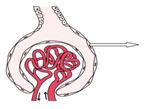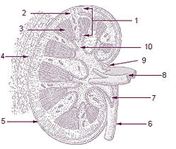Excretory Products and their Elimination - Online Test
Q1. Vasa recta is absent or reduced in:
Answer : Option B
Explaination / Solution:
The efferent arteriole emerging from the glomerulus forms a fine capillary network around the renal tubule called the peritubular capillaries.
A minute vessel of this network runs parallel to the Henle’s loop forming a ‘U’ shaped vasa recta. Vasa recta is absent or highly reduced in cortical nephrons.
Q2. Towards the centre of the inner concave surface of the kidney is a notch called:
Answer : Option D
Explaination / Solution:
On the medial margin of the kidney is concave region called the renal hilum. The renal hilum is the entrance to the renal sinus. Structures such as the renal veins, artery, nerves and lymphatic vessels are located in the renal hilum.
Q3. Label the following in diagram


Answer : Option B
Explaination / Solution:
The diagram shown above is Malpighian body or renal corpuscles. The marked part in this is called Podocytes or visceral epithelial cells in Bowman’s capsule in the kidney that warp around capillaries of the glomerules.
Q4.
In human excretory system :
i. kidneys and ureters are paired structures but urinary bladder is single.
ii. Kidneys are situated between the levels of last thoracic and third lumbar vertebra.
Answer : Option D
Explaination / Solution:
The excretory system in human consistsof a pair of kidneys, one pair of ureters, aurinary bladder and a urethra. Kidneys are reddish brown, bean shaped structures situated between the levels of last thoracic and third lumbarvertebra close to the dorsal inner wall of the abdominal cavity.
Q5. In the following diagram what are 7,9 & 10 :


Answer : Option D
Explaination / Solution:
Towards the centre of the innerconcave surface of the kidney is a notchcalled hilum through which ureter, bloodvessels and nerves enter. Inner to the hilumis a broad funnel shaped space called therenal pelvis with projections called calyces. The medulla is divided into a few conical masses projecting into the calyces. Thus, 7, 9, and 10 are pelvis, hilum and calyx respectively.
Q6. pH of urine under healthy conditions is :
Answer : Option C
Explaination / Solution:
The pH of urine under healthy conditions is slightly less than 7 so, slightly acidic in nature.
Q7. Which of the following is not a part of glomerular filtrate?
Answer : Option A
Explaination / Solution:
Glomerular filtrate contains glucose, inorganic salts and creatinine but it do not contain globulins protein.
Q8. The epithelial cells of Bowman’s capsule are called:
Answer : Option A
Explaination / Solution:
Podocytes are cells in the Bowman's capsule in the kidneys that wrap around capillaries of the glomerulus. The Bowman's capsule filters the blood, retaining large molecules such as proteins while smaller molecules such as water, salts, and sugars are filtered as the first step in the formation of urine.
Q9. Conditional reabsorption of sodium ions and water takes place in
Answer : Option D
Explaination / Solution:
Distal Convoluted Tubule (DCT): Conditional reabsorption of Na+ and water takes place in this segment. DCT is also capable of reabsorption of HCO3- and selective secretion of hydrogen and potassium ions and NH3 to maintain the pH and sodium-potassium balance in blood.
Q10. The filtration fraction is the ratio of GFR to RPF where both the values are in ml/min and FF is expressed in percentage. Calculate FF for a normal adult human being, if RPF= 600ml/min :
Answer : Option D
Explaination / Solution:
Filtration fraction is the ratio of glomerular filtration rate (GFR) to the renal plasma flow (RPF). GFR of normal human is 120 ml/min. so,
FF =
= = 20%.
